Myths about teaching can hold you back
- Year 9
Using lists to display outcomes for two events
I can systematically find all the possible outcomes for two events by listing them.
- Year 9
Using lists to display outcomes for two events
I can systematically find all the possible outcomes for two events by listing them.
These resources will be removed by end of Summer Term 2025.
Switch to our new teaching resources now - designed by teachers and leading subject experts, and tested in classrooms.
These resources were created for remote use during the pandemic and are not designed for classroom teaching.
Lesson details
Key learning points
- Possible outcomes for two events can be stated.
- Possible outcomes for two events can be listed.
- Possible outcomes for two events can be systematically listed.
Keywords
Systematically - When listing outcomes systematically, they are listed in such a way as to ensure all outcomes are recorded.
Common misconception
Pupils want to avoid writing lists of outcomes.
Always model and bring explicit attention to a systematic list. The benefits of working systematically is the likelihood of error is reduced.
To help you plan your year 9 maths lesson on: Using lists to display outcomes for two events, download all teaching resources for free and adapt to suit your pupils' needs...
To help you plan your year 9 maths lesson on: Using lists to display outcomes for two events, download all teaching resources for free and adapt to suit your pupils' needs.
The starter quiz will activate and check your pupils' prior knowledge, with versions available both with and without answers in PDF format.
We use learning cycles to break down learning into key concepts or ideas linked to the learning outcome. Each learning cycle features explanations with checks for understanding and practice tasks with feedback. All of this is found in our slide decks, ready for you to download and edit. The practice tasks are also available as printable worksheets and some lessons have additional materials with extra material you might need for teaching the lesson.
The assessment exit quiz will test your pupils' understanding of the key learning points.
Our video is a tool for planning, showing how other teachers might teach the lesson, offering helpful tips, modelled explanations and inspiration for your own delivery in the classroom. Plus, you can set it as homework or revision for pupils and keep their learning on track by sharing an online pupil version of this lesson.
Explore more key stage 3 maths lessons from the Probability: possible outcomes unit, dive into the full secondary maths curriculum, or learn more about lesson planning.

Licence
Prior knowledge starter quiz
6 Questions
Q1.5, 15, 20, 35, 750 are all multiples of .
Q2.Which of these numbers is not on a standard fair six-sided dice?
Q3.How many possible outcomes are there on this spinner?
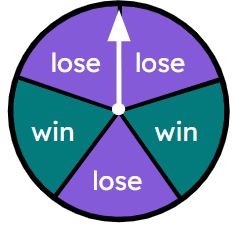
Q4.Match the spinner to the possible outcomes.

{apple, bread, carrot}
{apple, bread, carrot, melon}
{apple, banana, carrot}
{apple, carrot, melon}
Q5.When rolling a standard fair six-sided dice, which of these events would be equally likely to occur?
Q6.Laura correctly describes an event as having an unlikely chance of happening. According to the likelihood scale, which of these statements is true about the event?
Assessment exit quiz
6 Questions
Q1.These two spinner are spun. Which of the lists of outcomes have been completed systematically?
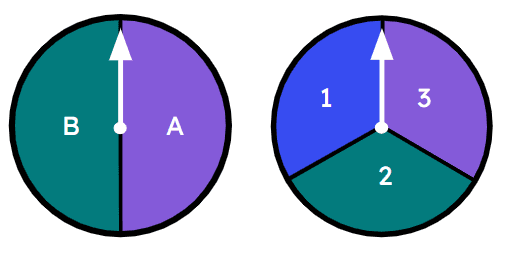




Q2.The list of outcomes from the two spinners has been composed non-systematically. The outcome has been omitted.
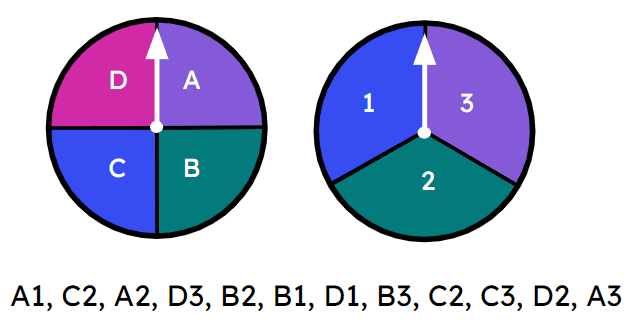
Q3.The outcomes of the two spinners can be systematically listed like this H1, H2, H3, H4, ... and so on.
Finish the list by putting the outcomes in the correct order.
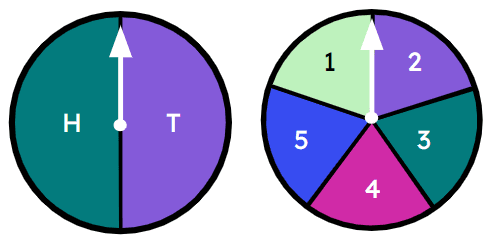
Q4.A standard fair six-sided dice is going to be rolled. Event A = {prime number} and event B = {multiple of 3}. Which of these outcomes are in both event A and event B?
Q5.This spinner is to be spun. Event A = {5 letter words} and event B = {words with consecutive double letters}. How many outcomes are in both event A and event B?
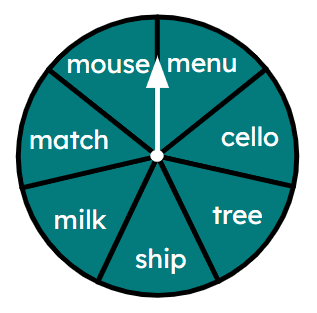
Q6.A standard fair six-sided dice is going to be rolled. Event A = {odd number} and event B = {4, 6}. Match the outcomes to the correct event.
{1, 3, 5}
{4, 6}
{1, 3, 4, 5, 6}
$$\emptyset$$
{2}


